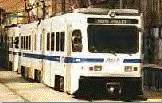
Light Rail Now and Walkable Neighborhoods (LRN) can be contacted at: Light Rail Now! |
Baltimore - Resounding New Light Rail Success on the East Coast Special Report by Light Rail Progress Baltimore's light rail transit (LRT) line, inaugurated in 1992, has been a tremendous success – carrying nearly 30,000 rider-trips a day. [Source: MTA website 00/04/06] That's about 3,000 trips in the highest peak hour – or about 2,700 trips in the peak direction, equivalent to more than 2 freeway lanes – another resounding illustration of the principle: "Build it, and they will come." (Yes, in 1992, some riders already used buses – but after 8 years, Light Rail Progress believes that, if the LRT line hadn't been built, most of today's riders would've been "lost" to the automobile, and would be included in the long queues of vehicles crammed into Baltimore's congested freeways.) in 1992, Baltimore's LRT cost $360 million, for the initial route of 22.5 miles. [Source: LTK Assocs., 96/06/11] in year 2000 dollars, that's approximately $422 million, or about $19 million per mile. That includes everything – right-of-way purchase, line construction, stations, vehicles, maintenance and storage facilities ... the works. Try building an urban freeway for $19 million a mile! (And freeway costs don't include the cost of the cars, parking spaces etc.) That's pretty inexpensive, even for light rail. Why is it so cheap? Because much of Baltimore's LRT system was built using existing railroad right-of-way, which is probably the lowest-cost type of LRT alignment to install. Since 1992, Baltimore's LRT has been expanded into a 30-mile system, running from Hunt Valley in Northern Baltimore County to Cromwell Station/Glen Burnie and BWI Airport in Anne Arundel County, south of Baltimore. And, because it's been such a success, more extensions are under way. There's an extension to Baltimore's Penn Station – about .34 mile (a third of a mile) from the main line. And the connection to BWI Airport is about 2.7 miles from the main line. [Source: MTA website 00/04/06] Why would Baltimore planners and decisionmakers be extending the system if it weren't a success? With 33 station-stops, Baltimore's LRT service averages 23.7 MPH. That's pretty competitive with the automobile, which averages about 25 MPH in most urban areas.
With 3-car trains (limited by the length of street blocks), and with maximum 2-minute headways assumed, that means the system could (theoretically) accommodate about 23,000 persons per hour – the equivalent of about 20 freeway lanes! Of course, it will be quite a while before that capacity is reached (and it will require the purchase of more light rail cars). But LRT's flexibility in providing people-moving capacity means that Baltimore's LRT has lots of capacity to handle special traffic demands, like sports and entertainment events, which can routinely overload streets and freeways well beyond their design capacity. And the system can adapt to increasing traffic growth for years to come! The bottom line: Baltimore's LRT proves that LRT can and will do what it says it does – and it's a tremendous benefit to Baltimore's total mobility system. Light rail can help shape Baltimore's future growth! Support light rail in Baltimore! |
|
|
|